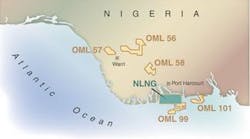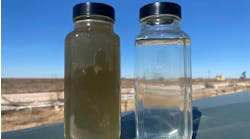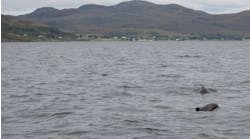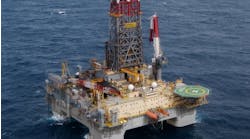First deepwater project close to approval
Jeremy Beckman
Editor, Europe
Zero-flaring, seen initially as a deterrent to investors, is helping to shape a wave of new development projects off Nigeria. Associated gas is being har-nessed more creatively, either as feed-stock for the expanding LNG terminal at Bonny Island, or as an oil recovery mech-anism for deepwater field developments.
Total, as a partner in Bonny and Shell-led Bonga project as well as operator of the newly onstream shallow-water field Amenam, is one of the more active majors in the region. Total has also been instrumental in several Nigerian deepwater discoveries, two of which may have established a new gas-prone province.
null
Prior to their merger in 2000, Total and Elf had different profiles in Nigeria. Total's focus was more on marketing, although its upstream subsidiary Total Upstream Nigeria Ltd. (Tupni) had just started exploration with the discovery of the Akpo field. Elf had been engaged in exploration and production for several decades. In 1962, its subsidiary company, known at the time as Safrap, made its first discovery onshore Nigeria. Elf's first operated production in the country, from the onshore Obagi field, followed four years later.
In 1974, the newly named Elf Petroleum Nigeria Ltd. was awarded its first offshore licenses in the shallow water southeastern sector. This led to the discovery, and subsequent development, of the Afia and Odudu fields, with Afia being the first to enter production in 1993. The same year, EPNL was awarded its first deepwater licenses, OPLs 222 and 223.
Following Afia/Odudu (in OML 100), production from the Ofon discovery, in adjacent OML 102, started in 1997. Here EPNL, as 40% operator, is partnered by Nigerian National Petroleum Corp. with 60%. Ofon, 50 km offshore in 35 m of water, was initially developed through two wellhead platforms and one production installation, with 18 oil producer wells and three water injectors. The facilities can handle up to 60,000 b/d, with oil exported through a 43-km, 12-in. pipeline to the Odudu complex. According to Jean-Paul Juguet, Total's vice president of Nigerian E&P, Ofon's areal extent has still to be delineated, and numerous satellite structures are being considered under future development plans.
Amenam expansion
Last July, EPNL also started production from the much larger Amenam/Kpono field, which straddles OML 99, and the ExxonMobil-operated OML 70, in 40 m of water. The field has been developed with two wellhead installations and one process platform. Processed crude is piped for storage to the 2.4-MMbbl-capacity FSO Unity, located between the Odudu and Ofon facilities and serving both fields.
Associated gas from Amenam/Kpono is currently reinjected, but under an approaching second phase, it will be transferred to the Bonny LNG plant, in which Total is a 15% shareholder, along with NNPC, Shell, and Agip. Bonny's first two trains started operating in 1999. After the third train started up in 2002, the partners announced plans for two further trains, which would raise the gas liquefaction plant's production capacity to 17 million metric tons/yr of LNG, 2.8 million metric tons/yr of LPG, and 1.1 million metric tons of condensate.
EPNL has onshore fields contributing to the first two trains. Units 4 and 5 are on track to start up respectively in 2005 and 2006, Juguet says. "Discussions are also under way for a sixth train, which we hope will be sanctioned later this year, in time for a start-up in 2007. At that point, Bonny would then have annual throughput of 22 million metric tons of LNG."
For Amenam/Kpono Phase 2, a second gas treatment platform, AMP2, will be installed, bridge-linked to the current AMP1 installation. Sime Semb. Corp. Engineering (SSE) will build the 10,000-metric-ton facility at a yard in Malaysia, near Singapore.
"It should also be noted that around 3,000 metric tons of miscellaneous components for the new offshore complex will be built in the Port Harcourt area of Nigeria," Juguet points out. AMP2 will process and dehydrate gas currently re-injected for onward export to Bonny. EPNL plans to switch to injected seawater for reservoir maintenance. This will also be treated on AMP2, with seawater injected through another new (wellhead) platform, AMD3. Both platforms should be delivered by 2005. Technip performed the front-end engineering.
AMP2 will also be equipped with additional compression and gas reception facilities to handle supplies from Ofon and Odudu, under a second development phase for these fields, probably implemented during 2007-08. That timing is necessary to comply with the government – and Total group's – policy of eliminating gas flaring. The program would likely include a second process platform on Ofon with gas recovery and additional oil production facilities. Here, conceptual studies are well advanced, and basic engineering is scheduled to start this year.
null
Supplies from Amenam/Kpono have boosted Total's operated production throughout Nigeria to an aggregate 230,000 boe/d. According to Juguet, EPNL's equity figure for fields where it is both operator and non-operator is roughly the same. This does not include its anticipated share from Shell's current deepwater Bonga development in OML 118, due onstream this year, where EPNL is a 12.5% partner. EPNL also participates in the Bonga SW discovery, currently undergoing development screening studies.
Usan breakthrough
Overall, EPNL operates 10 permits onshore and offshore Nigeria, and participates in a further 58. Two of the operated permits are deepwater OPLs 221 and 222. The latter, an 1,800-sq-km tract, was awarded under Nigeria's first deep-water licensing round in 1993.
Until 2002, Juguet explains, EPNL and its partners NNPC, ChevronTexaco, Esso, and Nexen "were not enthusiastic about this block. At that point, we had already drilled two exploration wells. Okpok-1, drilled in 1997, was so-so. Ukot-1, in 1998, was better, confirming the presence of hydrocarbons, but not in large quantities."
Feelings changed following the first well on the Usan structure in early 2002, drilled 10 km north of Ukot-1 by the semisubmersible Scarabeo VII. Usan-1, located 100 km offshore and in 750 m of water, test-flowed at a restricted rate of 5,000 b/d of 34° API crude. The well was terminated at a depth of 2,725 m.
Later that year, appraisal well Usan-2 was drilled about 4 km west of Usan-1, followed by Usan-3 in 2003, around 2 km northeast of Usan-2. A fourth well was drilled a few months later by the semi MG Hulme Jr., 5 km south of the original discovery. Last October, Total announced that this well had proved significant added potential in previously untested reservoirs. Two zones were tested, flowing respectively at 4,400 and 6,300 b/d. Earlier in 2003, another appraisal well had been drilled on Ukot, but there were no big surprises, according to Juguet.
The announcement of Usan-4 was designed "to let the market know that our first appraisal phase was successful, and that we had a significant discoveryU Usan is definitely the interesting part, and will remain the focus of our attention. We are working hard on development studies, although this is the type of block where you must be prudent about what you say. It takes time to appraise deepwater fields." Further exploration is planned this year on promising new targets elsewhere in the license.
Akpo delivers
OPL 246 is a 2,600-sq-km permit in the Niger Delta in water depths varying 1,100-1,800 m, deeper than OPL 222. It was awarded in 1998 to Nigerian company South Atlantic (60% interest), under an indigenous operator bidding round. Total (Tupni) acts as the delegated operator (technical adviser), with a 24% interest. Braspetro, a subsidiary of Petrobras, is the other partner, with 16%.
Here drilling has been successful from the outset. The first well, Akpo-1, was spudded in November 1999 on the eastern part of the permit, in a water depth of 1,375 m, and completed in April 2000, following two drillstem tests. These yielded flow rates of 9,000 b/d of light oil.
"We subsequently drilled four more appraisal wells on Akpo," Juguet says, "and one exploration well on the Kuro prospect in the far southwest of the block. Our exploration people felt there was good potential in this area, following analysis of the seismic. In fact, we found gas in Kuro, as was the case in the Doro discovery, not far away in neighboring block OPL 219, operated by Snepco, where we have 12.5%. At present, stranded gas in this area is not a priority, but it could be developed in future, after more wells have been put in. All our deepwater oil discoveries have associated gas, too. However, that does not mean the gas will be exported. It could also be used for enhanced oil recovery."
Juguet said Total now has suspended its campaign on the Akpo field, but is drilling wells elsewhere on the permit. One was on a structure 10-20 km west of Akpo, in 2003. This too found hydrocarbons and was tested.
"Recently, we spudded another well to probe a separate structure, and more wells could follow in 2004," he said. Exploration planning is not straightforward as elsewhere, however. "You have to set up priorities in your drilling sequence, i.e., securing drilling contracts, obtaining the necessary authorizations from the relevant authorities. It takes time, therefore, to explore your portfolio."
Newspaper reports have suggested that development planning for Akpo is well under way, based on a 2 MMbbl storage FPSO producing up to 185,000 b/d of oil, with a 150-km pipeline taking Akpo's gas direct to Bonny.
"We have received preliminary approvals from the authorities," Juguet confirms, "and we hope to gain all relevant approvals later this year. We can say that we are in talks with four contractor consortia concerning a permanently on-station FPSO. The current plan is that production from Akpo should start toward the end of 2007."
Recently, Total extended its position in Nigeria's deep offshore by signing a new production-sharing contract for OPL 221, just west of OPL 222. NNPC is the concession holder, but EPNL is 100% operator.
"What we found with Usan will probably motivate us to explore this license more quickly," Juguet adds.





